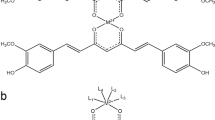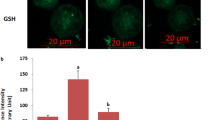Abstract
The mitochondrial aconitase (mACON) containing a [4Fe-4S] cluster is regarded as the key enzyme for citrate oxidation in the epithelial cells of human prostate. In vitro studies using the human prostatic carcinoma cells, PC-3 cells, found that both hemin and ferric ammonium citrate (FAC) significantly increased mACON enzymatic activity and gene expression. The effect of FAC on mACON was enhanced 2-fold by co-treating with ascorbic acid but blocked by co-treating with iron chelator, deferoxamine mesylate. Hemin treatments blocked 30% of citrate secretion from PC-3 cells but upregualted 2-fold of intracellular ATP biosynthesis. Results from reporter assay by using a cytomegalovirus enhance/promoter driven luciferase mRNA ligated to the iron response element (IRE) of mACON as a reporter construct demonstrated that modulation of FAC on gene translation of mACON gene is dependent on the IRE. Transient gene expression assays indicated that upregulation of mACON gene transcription by FAC may through the putative antioxidant response element (ARE) signal pathway. This study provides the first evidence of the biologic mechanism of human mACON gene translation/transcription and suggests a regulatory link between the energy utilization and the iron metabolism in human prostatic carcinoma cells. (Mol Cell Biochem 265: 185–194, 2004)
Similar content being viewed by others
References
Emptage MH, Kent TA, Kennedy MC, Beinert H, Munck E: Mossbauer and EPR studies of activated aconitases: Development of a localized valence state at a subsite of the [4Fe-4S] cluster on binding of citrate. Proc Natl Acad Sci USA 80: 4674–4678, 1983
Kennedy MC, Mende-Mueller L, Blondin GA, Beiner H: Purification and characterization of cytosolic aconitase from beef liver and its rela-tionship to the iron-responsive element binding protein. Proc Natl Acad Sci USA 89: 11730–11734, 1992
Addess KJ, Basilion JP, Klausner RD, Rouault TA, Pardi A: Structure and dynamics of the iron responsive element RNA: Implications for binding of the RNA by iron regulatory binding proteins. J Mol Biol 274: 72–83, 1997
Kim H-Y, KaVaute T, Iwai K, Klausner RD, Rouault TA: Identifi-cation of a conserved and functional iron-responsive element in the 5-untranslated region of mammalian mitochondrial aconitases. J Biol Chem 271: 24226–24230, 1996
Henderson BR, Menotti E, Kuhn LC: Iron regulatory proteins 1 and 2 bind distinct sets of RNA target sequences. J Biol Chem 271: 4900–4908, 1996
Ke Y, Wu J, Leibold EA, Walden WE, Theil EC: Loops and bulge/loops in iron-responsive element isoforms influence iron regulatory protein binding. Fine-tuning of mRNA regulation? J Biol Chem 273: 23637–23640, 1998
Klausner RD, Rouault TA: A double life: Cytosolic aconitase as a reg-ulatory RNA binding protein. Mol Biol Cell 4: 1–5, 1993
O'Halloran TV: Transition metals in control of gene expression. Science 261: 715–725, 1993
Costello LC, Franklin RB: Concepts of citrate production and secretion by prostate: 1 Metabolic relationships. Prostate 18: 25–46, 1991
Juang HH: Modulation of mitochondrial aconitase on the bioenergy of human prostate carcinoma cells. Mol Genet Metab 81: 244–252, 2004
Ross KL, Eisenstein RS: Iron deficiency decreases mitochondrial aconi-tases abundance and citrate concentration without affecting tricar-boxylic acid cycle capacity in rat liver. J Nutr 132: 643–651, 2002
Schalinske KL, Chen OS, Eisenstein RS: Iron differentially stimulates translation of mitochondrial aconitase and ferritin mRNAs in mam-malian cells. Implications for iron regulatory proteins as regulators of mitochondrial citrate utilization. J Biol Chem 273: 3740–3746, 1998
Janson L, Bark C, Pettersson U: Identification of proteins interacting with the enhancer of human U2 small nuclear RNA genes. Nucleic Acids Res 15: 4997–5016, 1987
Labbe S, Thiele DJ: Copper ion inducible and repressible promoter systems in yeast. Methods Enzymol 306: 145–153, 1999
Nguyen TH, Huang C, Pickett CB: Transcriptional regulation of the antioxidant response element. J Biol Chem 275: 15466–15473, 2000
Head JF, Wang F, Elliott RL: Antineoplastic drugs that interfere with iron metabolism in cancer cells. Adv Enzyme Regul 37: 147–169, 1997
Ponka P, Lok CN: The transferrin receptor: Role in health and disease. Int J Biochem Cell Biol 31: 1111–1137, 1999
Kwok JC, Richardson DR: The iron metabolism of neoplastic cells: Alterations that facilitate proliferation. Crit Rev Oncol Hemat 42: 65–78, 2002
Kristal AR, Stanford JL, Cohen JH, Wicklund K, Patterson RE:Vitamin and mineral supplement use is associated with reduced risk of prostate cancer. Cancer Epidemiol Biomarkers Prev 8: 887–92, 1999
Thomas JA: Diet, micronutrients, and the prostate gland. Nutr Rev 57: 95–103, 1999
Franklin RB, Juang HH, Zou J, Costello LC: Regulation of citrate metabolism by androgen in LNCaP human prostate carcinoma cell line. Endocr J 3: 603–607, 1995
Juang HH, Costello LC, Franklin RB: Androgen modulation of multiple start sites of the mitochondrial aspartate aminotransferase gene in rat prostate. J Biol Chem 270: 12629–12634, 1995
Costello LC, Franklin RB: The bioenergetic theory of prostate malig-nancy. Prostate 25: 162–166, 1994
Gray NK, Pantopoulos K, Dandekar T, Ackrell BA, Hentze MW: Trans-lational regulation of mammalian and Drosophila citric acid cycle en-zymes via iron-responsive elements. Proc Natl Acad Sci USA 93: 4925–4930, 1996
Kim YC, Masutani H, Yamaguchi Y, Itoh K, Yamamoto M, Yodoi J: Hemin-induced activation of the thioredoxin gene by Nrf2. Adifferential regulation of the antioxidant responsive element by a switch of its bind-ing factors. J Biol Chem 276: 18399–18406, 2001
Theil EC, Eisenstein RS: Combinatorial mRNA regulation: Iron regula-tory proteins and iso-iron-responsive elements (Iso-IREs). J Biol Chem 275: 40659–40662, 2000
Walden WE: From bacteria to mitochondria: Aconitase yields surprises. Proc Natl Acad Sci USA 99: 4138–4140, 2002
Seligman PA, Schleicher RB, Siriwardana G, Domenico J, Gelfand EW: Effects of agents that inhibit cellular iron incorporation on bladder can-cer cell proliferation. Blood 82: 1608–1617, 1993
Graham RM, Morgan EH, Baker E: Ferric citrate uptake by cultured rat hepatocytes is inhibited in the presence of transferrin. Eur J Biochem 253: 139–145, 1998
Hammer A, Ferro M, Tillian HM, Tatzber F, Zollner H, Schauenstein E, Schaur RJ: Effect of oxidative stress by iron on 4-hydroxynonenal formation and proliferative activity in hepatomas of different degrees of differentiation. Free Radic Biol Med 23: 26–33, 1997
Radtke K, Lornitzo FA, Byrnes RW, Antholine WE, Petering DH: Iron requirement for cellular DNA damage and growth inhibition by hydro-gen peroxide and bleomycin. Biochem J 352: 655–664, 1994
Rossi MC, Zetter BR: Selective stimulation of prostatic carcinoma cell proliferation by transferrin. Proc Natl Acad Sci USA 89: 6197–6201, 1992
Gosiewska A, Mahmoodian F, Peterkofsky B: Gene expression of iron-related proteins during iron deficiency caused by scurvy in guinea pigs. Arch Biochem Biophys 325: 295–303, 1996
Toth I, Bridges KR: Ascorbic acid enhances ferritin mRNA translation by an IRP/aconitase switch. J Biol Chem 270: 19540–19544, 1995
Toth I, Rogers JT, McPhee JA, Elliott SM, Abramson SL, Bridges KR: Ascorbic acid enhances iron-induced ferritin translation in human leukemia and hepatoma cells. J Biol Chem 271: 2846–2852, 1996
Eisenstein RS, Blemings KP: Iron regulatory proteins, iron responsive elements and iron homeostasis. J Nutr 128: 2295–2298, 1998
Theil EC: Iron regulatory elements (IREs): A family of mRNA non-coding sequences. Biochem J 304: 1–11, 1994
Tsuji Y, Ayaki H, Whitman SP, Morrow CS, Torti SV, Torti FM: Coor-dinate transcriptional and translational regulation of ferritin in response to oxidative stress. Mol Cell Biol 20: 5818–5827, 2000
Tong X, Kawabata H, Koeffler HP: Iron deficiency can upregulate ex-pression of transferrin receptor at both the mRNA and protein level. Br J Haematol 116: 458–464, 2002
Hon T, Hach A, Lee HC, Cheng T, Zhang L: Functional analysis of heme regulatory elements of the transcriptional activator Hap1. Biochem Biophy Res Commun 273: 584–591, 2000
Ogawa K, Sun J, Taketani S, Nakajima O, Nishitani C, Sassa S, Hayashi N, Yamamoto M, Shibahara S, Fujita H, Igarashi K: Heme mediates derepression of Maf recognition element through direct binding to tran-scription repressor Bach1. EMBO J 20: 2835–2843, 2001
Beaudoin J, Labbe S: The fission yeast copper-sensing transcription factor Cufi regulates the copper transporter gene expression through an Ace/Amt1-like recognition sequence. J Biol Chem 276: 15472–15480, 2001
Ogra Y, Suzuki K, Gong P, Otsuka F, Koizumi S: Negative regulatory role of Sp1 in metal responsive element-mediated transcriptional activation. J Biol Chem 276: 16534–16539, 2001
Murata M, Gong P, Suzuki K, Koizumi S: Differential metal response and regulation of human heavy metal-inducible genes. J Cell Physiol 180: 105–113, 1999
Chu WA, Moehlenkamp JD, Bittel D, Andrews GK, Johnson JA: Cadmium-mediated activation of the metal response element in human neuroblastoma cells lacking functional metal response element-binding transcription factor-1. J Biol Chem 274: 5279–5284, 1999
Author information
Authors and Affiliations
Rights and permissions
About this article
Cite this article
Juang, HH. Modulation of iron on mitochondrial aconitase expression in human prostatic carcinoma cells. Mol Cell Biochem 265, 185–194 (2004). https://doi.org/10.1023/B:MCBI.0000044395.59739.1f
Issue Date:
DOI: https://doi.org/10.1023/B:MCBI.0000044395.59739.1f




